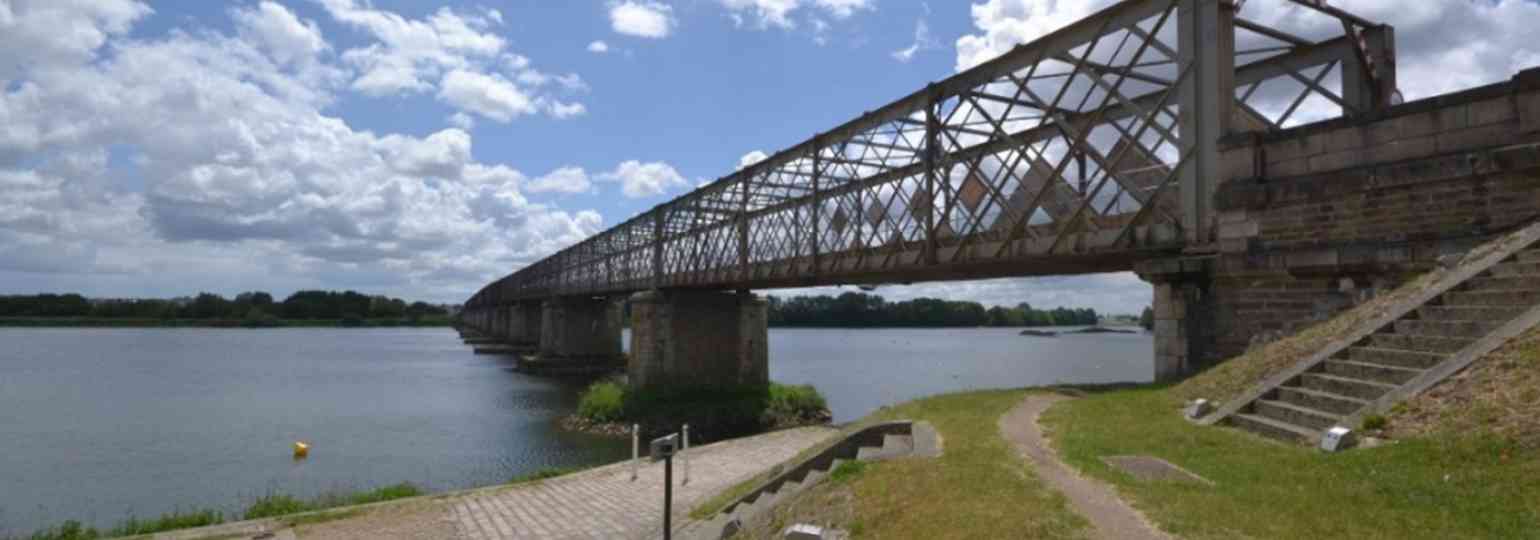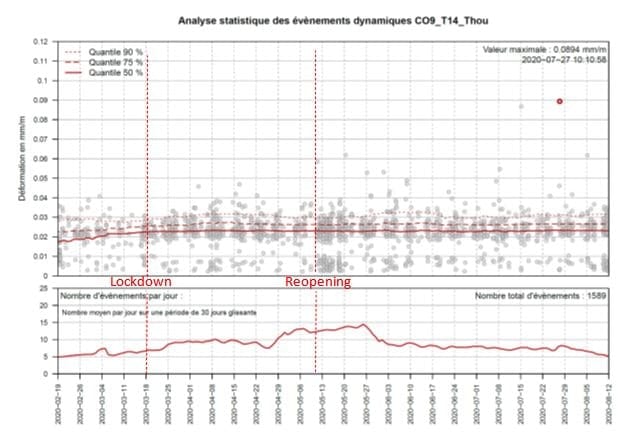
The Loire-Atlantique Departmental Council has taken a preventive approach in commissioning OSMOS to check the real-world mechanical behavior of two bridges over the river. The enhanced monitoring of those structures will maintain their service levels and ensure user safety, while awaiting major rehabilitation work.
Built in the late 19th century, the Grand Pont de Mauves and Haut Village Bridges are part of a group of four strategic structures that connect the banks of the Loire to the east of Nantes. Periodic detailed inspections identified multiple problems, including signs of progressive corrosion, advanced deterioration of the brick arches under the deck and differential settlement of the supports. That damage was caused by the age of the bridges, their permeability and the intensification of the traffic traveling over them.
To maintain its structures’ level of service while guaranteeing user safety, the Loire-Atlantique Department Council decided to invest several million euros in an enhanced monitoring and specialized maintenance program for its infrastructure. With those renovations in mind, the Civil Engineering Department commissioned OSMOS to monitor the behavior of the Grand Pont de Mauves, while awaiting its restoration as part of a series of rehabilitation and modernization work. The Haut Village Bridge was then monitored to assess the effects of the additional road traffic that would be diverted to it during the work performed on the bridge line at Mauves-sur-Loire. This made it possible to avoid shutting down the Grand Pont de Mauves early, a move that would have been costly and inconvenient for its users.
Monitoring of the Mauves Bridge: Ensuring optimal user safety while keeping the structure under enhanced monitoring, leading up to its restoration
The Grand Pont de Mauves had been covered by enhanced monitoring since 2002, as part of periodic monitoring and inspection procedures. In 2018, after pitting corrosion was observed in a number of floor beams, visual inspections by rappellers were arranged in parallel to the schedule of renovation work to restore the bridge. Before that project was launched, the Loire-Atlantique Departmental Council wanted to have continuous, real-time monitoring while the bridge was still in operation, to prevent its premature closure and to control any structural risks. OSMOS was asked to roll out a monitoring system seven months prior to the start of work on the bridge. The goal was to continuously check its elasticity and displacement, in real time, as well as any day-to-day deformation caused by moving loads.
After a period spent studying the Mauves Bridge’s behavior, OSMOS was able to notify the contracting authority of any significant events indicating a change in its overall stability, particularly as a result of temperature fluctuations and moving loads. On the whole, the structure displayed good stability, with a slight tendency toward tension in Span 11. Most of the dynamic strain generated by road traffic was of a low magnitude and had no harmful effects on the bridge’s mechanical behavior. Only the passage of certain heavy vehicles had an irreversible impact on the framework of the bridge. An analysis of all of the deformation amplitudes associated with moving loads revealed that the strain was substantially higher on one part of the bridge. That area appeared to be more “strained” than the others when heavy vehicles passed over it, as a result of localized deterioration of rigidity.
Assessing the effects of the traffic diverted to the Haut Village Bridge: Would the additional moving loads pose a threat to the state of the structure?
In anticipation of the diversion of traffic to the Haut Village Bridge during work on the Mauves Bridge, the Loire-Atlantique Department asked OSMOS to place the structure under continuous monitoring. This was because, despite the renovation work and repairs performed on it in recent years, the Haut Village Bridge’s load-bearing capacity was still limited, due to the aging of its materials and its original design. The contracting authority wanted to understand how the structure would actually behave under the “over-strain” caused by the traffic detour. The monitoring also made it possible to refine the modeling assumptions for the bridge and determine the maximum load it could bear.
The structural deformations demonstrated even amplitudes, consistent between the spans, as well as a good correlation to heat fluctuations. The statistical analysis of dynamic events, shown below, highlights the effects of the lockdown on road traffic, including a decline in the frequency of heavy vehicle crossings. Despite a rise in traffic during the 10 days following May 11, 2020, the date when the lockdown was lifted, it eventually returned to the frequency observed during the lockdown. Out of all of the dynamic events, two unusual crossings were recorded, with effects three times higher than the usual consequences of heavy vehicles on the bridge. After those first six months of monitoring, the structure’s behavior displayed long-term stability and responses that were consistent with its traffic loads, even unusual loads. The following months further enriched this analysis.

Placing the Mauves Bridge under enhanced structural monitoring while awaiting its renovation, and the Haut Village Bridge during that work, allowed the administrator to maintain operations with guaranteed user safety. The data obtained from OSMOS’s monitoring and statistical analyses will be extremely useful to the Loire-Atlantique Departmental Council when it comes time to recalculate its structures. That way, the contracting authority will be able to verify that their condition is still in line with the expected level of service. The management of this infrastructure can then be oriented so as to ensure their availability and control their structural integrity over time.
Testimonial from Thibaut Pannetier, Head of the Loire-Atlantique Civil Engineering Department
“Under our strategy of monitoring the infrastructure along the Mauves and Thouaré bridge lines, we needed to supplement our inspections with a more comprehensive structural approach. It was difficult to control structural risk through the enhanced monitoring performed on the bridges of Mauves, based solely on corrosion measurements and the losses of material observed during semiannual inspections. In particular, the 19th-century bridge design, in the form of riveted connections between plates and multiple trusses with brick arches, would have been complicated to recalculate or would have required the development of calculation models whose modeling time and methods were not in line with the short-term issues related to keeping crossings safe before shutting down the bridge for work.
That’s why we reached out to OSMOS, after sourcing providers in 2019, to install a solution using Optical Strands that would avoid the need for lengthy, complex calculations and that would provide a continuous, quantitative observational approach. It was vital for us to make sure of the bridge’s structural elasticity. Otherwise, we would have had to make the call to shut it down, in a geographic area with relatively few crossing points, making detours very costly for both users and local businesses.
In parallel, the instrumentation installed on the Haut Village Bridge for the same reasons allowed us to make sure it would continue to function correctly when traffic was diverted during work on the bridges in Mauves.
The assistance provided by OSMOS easily satisfied our needs. The team understood our approaches and our constraints, so they were able to recommend instrumentation capable of controlling the risks to people and property. Their responsiveness when rolling out the solution and setting up the support engineering was effective, making this collaboration an experience worth reproducing for contracting authorities managing an infrastructure of complex, aging bridges along strategic roadways. This successful experience is undoubtedly the start of a new orientation for instrumentation strategies, as a complement to periodic inspections and ad hoc assessments.
Finally, the instrumentation on the Haut Village Bridge also allowed the Civil Engineering Department to finalize its calculation model through various iterations, by comparing the digital results with the actual displacement measurements.”
